![]()
1. WHEN AND WHERE DOES THE MOVIE TAKE PLACE ?
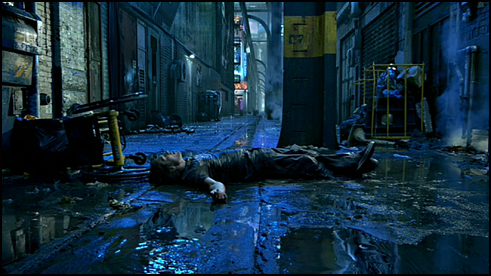
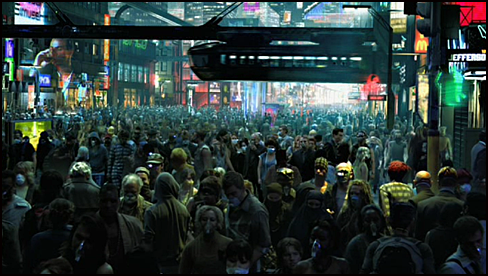
James Cameron: The story takes place in 22nd century (2154). Most of the action takes place on Pandora, which is not actually a planet, it’s a large moon of a gas giant planet called Polyphemus in the Alpha Centauri A star system. Pandora is Earth-like, has lush rain forest environment and they’re filled with incredible life forms like a thousand foot tall trees, and a myriad of creatures, some of which are quite beautiful and some of which are quite terrifying which you’ll definitely see in the game. Pandora is also home to Na’vi.
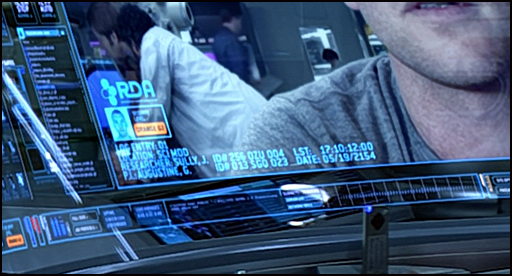
Dr. Grace Augustine (Avatar Featurette):
From Earth’s southern hemisphere, you can see the solar system where Pandora is located, Alpha Centauri. At a distance of 4.4 light years from Earth, the Alpha Centauri system is our nearest stellar neighbor. The largest of its two sun like stars, Alpha Centauri A or ACA to astronomers is Pandora's sun. Pandora is one of many moons orbiting the planet Polyphemus, the gas giant of the size of Saturn. Pandora's toxic atmosphere makes it uninhabitable by humans. Tropic rainforest covers the large part of each of the continents. These rainforests are similar to those that once covered the Amazon basin, but on the scale several times of anything on earth.
From what scientists can tell, the Pandora ecology works and communicates like a nervous system, suggesting a symbiotic relationship between all things Pandora. Perhaps the best symbols of this relationship are small luminescent Wood sprites, which are the seeds of the d’Utraya Mokri, the tree of souls. The tree is sacred to the Na'vi and believed to be the heart of the deep connection of all life.
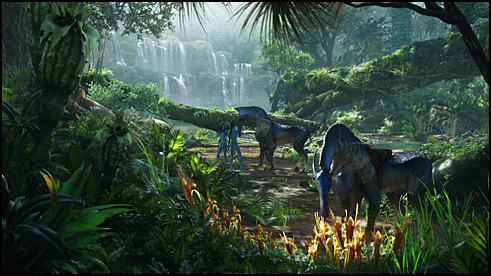
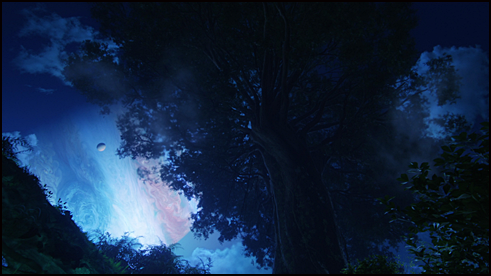
Everything on Pandora -- including the 10-foot, blue-skinned Na'vi -- is big because the gravity is 80 percent of what it is on Earth.
Cameron has put Pandora and Polyphemus in the real Alpha Centauri star system, the closest star system to Earth. The system is actually three stars all revolving around one another. The biggest is 20 percent larger than the Sun, the second is 15 percent smaller than the Sun, and the third is a red dwarf 80 percent smaller than the Sun. Polyphemus is named for the one-eyed Cyclops in Homer's "Odyssey." In the film, a gigantic storm similar to Jupiter's Great Red Spot is visible.
2. WHAT IS THE SONG PLAYED IN THE BAR ?
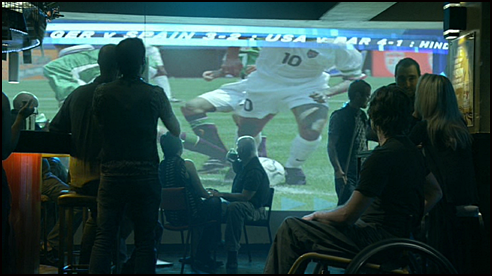
The song is called "Bless the Plague" by Discovery Zone. Discovery Zone is the band of Jon Landau's son, Jamie Landau
3. WHAT IS THE NAME OF THE COMPANY ?

RDA. The largest single non-governmental organization in the human universe. Massive corporation involved in interests ranging from mining, transportation, medicines, weapons and communications. More powerful than most Earth governments The Resources Development Administration (RDA) has monopoly rights to all products shipped, derived or developed from Pandora and any other off-Earth location. These rights were granted to RDA in perpetuity by the Interplanetary Commerce Administration (ICA), with the stipulation that they abide by a treaty that prohibits weapons of mass destruction and limits military power in space.

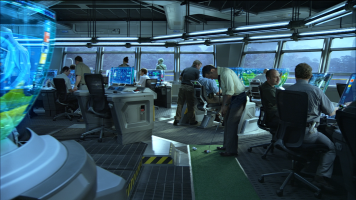
With
millions of shareholders, RDA is the oldest and largest of the
quasi-governmental administrative entities (QGAEs). But its origins are far more
modest. The entity that would become RDA was little more than a Silicon Valley
garage startup in the early 21st century, when its two founders borrowed money
from family members to begin the company.
Within a few decades, the company had the stature to propose the construction of
a world-spanning rapid transit system that would allow entire population groups
to conveniently commute hundreds or even thousands of miles to perform work
where it was needed, without impinging on the cultural values of host
populations. This led to the current global network of maglev trains that
require the superconductor unobtanium for their continued operation.
The company's early expeditions to Pandora were seen as a colossal risk; the
construction of the first interstellar vehicle alone put an enormous strain on
capital resources. But with exclusive mining rights to unobtanium (which, at
time of publication is valued at $20 million per kilo), and potential profits
from countervirals, biofuels, and cosmetics, the enormous capital investment has
paid off.
From Pandorapedia
3. HOW DOES THE ISV VENTURE STAR TRAVEL WITHOUT LIGHT SPEED ?
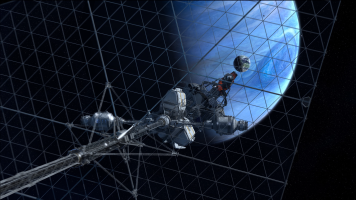
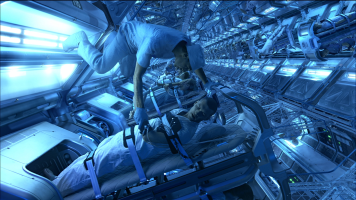
According to Ben Procter, James Cameron wrote a ten-page document addressing
this very question, "which became my bible as I led a team of talented 3D
designers (Tex Kadonaga, Joe Hiura, and Rob Johnson) in the development of the
exterior design." The document includes sketches, as well as entire section on
the ship's propulsion technology, which uses matter/antimatter reaction,
complete with speed and trip duration calculations. There's also "a wealth of
information on the ship's components and their relative layout."
Adds Procter: The huge glowing radiators mounted to the engines dissipate
their heat, and the enormously long central truss, with its own protective
coolers and reflectors, protects the cargo and crew modules from the engines'
heat and radiation using the simple rule of r-squared attenuation rather than
heavy shielding. (Yes, Jim really thinks about this kind of stuff and explains
it very clearly in text and in person.) The ship has a pair of
centrifugal-gravity-gen modules for the crew who remain awake for the duration,
which has become a pretty typical feature of quasi-realistic ship designs in
movies. But one unique feature it has which directly relates to the sub-light
realistic travel is a cascade-style shield stack to protect the speeding craft
from interstallar debris. Jim's doc completely explains this technology,
apparently based on current NASA research, and how it obliterates potentially
catastrophic particles by letting them slam through a series of thin, light
shield surfaces.
To make a long story short, the VStar is definitely not your typical movie ship
and it's all due to Jim's engineering knowledge and passion. It was a privilege
to work on this design that he'd clearly invested so much thought into.
Emmy winning designer Robert Stromberg: One way that it is very different is that in Avatar, Jim is very science-based and very physics-based. So everything is not only plausible but you could build things and they would actually work. Jim is just very much into the reality of things. Even the hometree on Pandora was very specifically tested and computer-modeled so that the base of it would support a tree of that height... the design of it was grounded in physics
James Cameron: The ship was configured to be a combination of antimatter engine and beamed energy from Earth with some, you know, giant laser. So that big mirror on the ship is actually a thermal shield. (...). That mirror just protected the habitable portion of the ship from incineration by the beamed energy. So the beamed energy outbound and then use the antimatter engine for deceleration into the Alpha Centauri A system then kinda works in reverse on the way back.
It’s the most science grounded fantasy ever put on the big screen – Planetary Society Organization
4. WHO ARE THE NA'VI ?
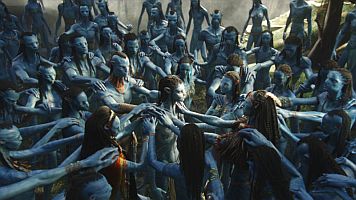
![]()
James Cameron: Na’vi are a humanoid race which lives in a state that we would consider primitive, bows and arrows and primitive weapons and that sort of thing, but who ultimately prove to be much wiser than we are. The Na’vi are 10feet tall, blue skin, striped like tigers, they have long tails , they’re quite fierce looking and they can be ferocious warriors when they’re provoked, but normally as when humans are not trampling their planet, they live harmoniously in their forest environment.
The Na'vi
are the only known species outside of Earth to have human-like intelligence.
Although their society is essentially Neolithic, they have developed a vibrant,
complex culture based on a profound spiritual connection to their moon, to one
another, and to the deity they call Eywa. They are superb artisans who celebrate
the interconnectedness of nature through storytelling, song, dance and crafts.
In many respects, the Na'vi body is almost human-like (and, even by human
standards, beautiful). The waist is narrow and elongated. The shoulders are very
wide, creating a v-shaped upper back. The neck is twice as long as an average
human and can rotate, owl-like, almost 180 degrees. The body overall is more
slender than the average human and is reminiscent of a Masai or Watusi. But the
musculature is sharply defined, giving no sense of emaciation despite the thin
proportions (they have roughly four times the strength of the average human).
Their almond-shaped, cat-like eyes are large and hypersensitive to various bands
of light. For balancing their long torso and legs, the Na'vi have a long,
prehensile lemur-like tail. They can traverse the landscape on the surface as
well as from tree branch to tree branch.
The abundant flora and fauna of Pandora have ensured a steady population of
Na'vi; it is hypothesized that there was little Darwinian pressure to adapt new
traits. Indeed, studies indicate that the number of Na'vi have remained
remarkably consistent over the eons. The widespread access to natural resources
has also helped limit (but not eliminate) warfare among the various Na'vi clans.
There are hundreds of disparate Na'vi clans on Pandora. Some of the clans, including the Omaticaya, live in ancient trees that are two to three times the height of the Terran redwoods that once covered the Pacific Northwest. The circumference of Hometree is great enough to house dozens of clan members. The tree is honeycombed with natural hollows and alcoves in which the Na'vi sleep, eat, weave, dance, and celebrate their connection to Eywa. Like many sacred sites on Pandora, Hometree sits above a large deposit of Unobtanium.
From Pandorapedia
According to designer Craig Shoji, the Na'Vi's main protein source is "teylu grubs." He worked on a deleted scene showing Na'Vi food-sharing and drinking rituals, and designed some of their housewares.
The Na'vi were designed by Stan Winston
Stan Winston: "Our biggest job in this project is the final design of the (Na'vi) characters. Virtually all of the digital work is being done by WETA but its based on our characters. The characters come from Stan Winston's Studio
Each one individually has a really character so its not like once you see the Na'vi you know, they all look alike. They all have very implicit, very distinctive character
The characters that we’ve designed and taken to that next step and Winstonized them are awesome and its brilliant."

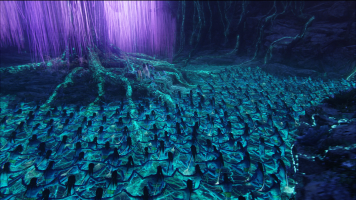
5. WHAT IS AN AVATAR ?
Avatar is a genetically engineered human-Na'vi hybrid. James Cameron: The avatars in our story are living breathing bodies in a real world, they’re not , as the word has sort of been appropriated by the cybersphere, they’re not synthetic alter egos in cyberspace, just to be clear that its not a matrix type of story. And the avatar bodies are controlled by human driver who projects his consciousness by a technology which links their mind to the avatar body and they kind of live through that body as a kind of , in a kind of remote control, while their human body is in coma like state
The Avatar Program was originally intended to create mine workers who did not need environmental protection systems and could eat Pandoran foodstuffs. But the cost of the mental link system remained too high for the numbers needed. Avatars are now used only for field work and, when the opportunity arises, to interact with the Na’vi, to study them and to study the Pandoran ecosystem. It was hoped that the avatars could act as unofficial ambassadors, but Na'vi have for the most part viewed these hybrid creatures with a mix of contempt and mistrust.
The cloned avatar has the body structure and physiology of a Pandoran native.
However, adding the human genes necessary to create the mental linking ability
to the avatar's genetic makeup altered the anatomy to the extent of producing
five digits (different from the normal four on a Na'vi) on the hands and feet,
and reducing the size of the eyeballs. The reason for this is not yet known.
The Avatar Program was initiated to improve communication with the Na’vi, the
intelligent humanoid inhabitants of Pandora. Human volunteers are paired with
avatars, which are artificially created human/Na’vi hybrids controlled by
persona projection technology. While the human controller remains in a
sleep-like state in a psionic link unit, his or her personality inhabits and
completely controls a custom-made Na’vi body.
The link is total; the human believes he is actually inhabiting the Na’vi body,
with all senses, reflexes and bodily functions fully operational. The avatar
body, having been grown in an amnio tank with the help of growth accelerants,
has no personality of its own and is inert (except for basic autonomous
functions) when not under human control.
Each avatar is specially made using genetic information from its human
controller and despite obvious differences in size and physiology is equivalent
to its controller’s twin. This genetic matching is necessary to allow morphic
projection to operate on the alien body; attempts to use unmatched bodies have
invariably failed.
Originally part of RDA’s Na’vi outreach program instigated at the behest of
Earth government authorities, the Avatar Program has moved from being a
poorly-defined xenobiological experiment controlled by Earth-based bureaucrats,
ivory-tower academics and populist politicians to become a tightly-managed
engineering project incorporating the most advanced technology from RDA’s labs.
![]()
The existence of the Na’vi was the most surprising discovery on Pandora. For
theoretical reasons, intelligent life was not expected to be found here. Given
the known age of the galaxy and the relatively brief period since the evolution
of man, it was assumed that any alien intelligence would be far older and more
sophisticated than us, would have an advanced technological civilization and
probably not be humanoid. Thus the discovery of jungle-dwelling neolithic
humanoids was not anticipated.
Under strong pressure from the UN, scientists and the general public, the RDA
agreed to set up a program to enhance communications between humans and Na’vi.
At first this consisted solely of an Indigenous Terrain program to study Na’vi
culture and language and to attempt to establish communication between man and
Na’vi.
But practical difficulties soon showed a need for a more profound means of
communication between the human and Na’vi species. RDA research had already
established the possibility of direct mental communication between humans, and
RDA scientist Dr. Cordell Lovecraft was given the task of carrying his “Dark
Dreamer” project, which sought to transmit mental processes – “thoughts” – to
humans at a distance, to interspecies communication.
Initial dissection of Na’vi specimens found that although Na’vi show a
surprising degree of external convergent evolution, internally they are quite
different from humans. The Na’vi brain in particular, with its external tendrils
and three-lobed structure was a daunting obstacle.
Building on work with brain-wiped primates and condemned criminals, Dr.
Lovecraft was able to establish that full sensory bonding could be established
between human twins, human-animal hybrids that shared common DNA, and
human-Na’vi hybrids with common genetic blueprints.
Since Na’vi don’t use DNA or RNA to carry their genetic information, producing a
‘translation table’ that matched DNA with NVTranscriptase closely enough to
allow a level of morphic resonance strong enough for communication to occur
required months of computer time and multiple failed experiments, some of which
caused irreparable trauma to volunteer subjects.
But eventually the Avatar Program succeeded in producing the first viable
hybrids between completely unrelated species – a considerable achievement since,
as Dr Lovecraft remarked, humans are far more closely related genetically to
garden slugs than to Na’vi.
With the help of psionic amplification, and thanks to customized reception nodes
grown into avatar brains from their earliest blastomere stage of development,
human drivers can now operate their avatars at distances of tens of kilometers.
Owing to poor measurable outcomes in the field, the Indigenous Terrain program
and the Avatar Program were eventually merged, with only limited informal
research still conducted into Na’vi culture by human avatar operators. Currently
avatars are mainly used for reconnaissance, liaison and exploration, but if
native Na’vi are recruited into the mining workforce it is anticipated that more
avatars will be needed for supervision and policing.
Dr. Lovecraft has been nominated for multiple Nobel prizes in biological
sciences, but the nominations have invariably been withdrawn following protests
from human rights organizations, the UN Pan-Faith Council and animal rights
activists.
From Pandorapedia
![]()
6. HOW DOES THE AVATAR CHAMBER WORK ?
![]()
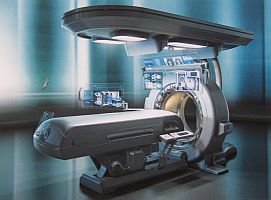
According to designer Yuri Bartoli, whose early sketches are remarkably close to the final product, the resemblance to an MRI is intentional. The big "ring" that the coffin slides inside spins around really quickly, to capture views of your brain within an intense magnetic field. But it has to be a two-way system, of course: as the coffin slides inside the field the ring generates, it becomes part of a feedback system, reading the occupant's brain and feeding back sensory impressions from the Avatar.
The designers considered having Jake suspended in some kind of fluid or on top of gel, that would allow for blood circulation while the Avatar "driver" is immobile for long periods of time, says Bartoli. "Design-wise we always tried to strike a balance between having the technology look functional and cool at the same time."
7. WHAT IS UNOBTAINIUM USED FOR ?
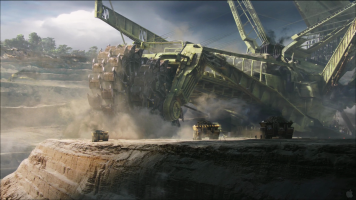
Unobtanium has more of a symbolic role in the movie.
James Cameron (LePost.fr): The studio executives, they read the script and they said "well you never explain what this mineral is used for". I said "I don’t wanna explain it". And I don’t in the movie, its never explained what its used for. (…) Its whatever gets people up out of there cities to get on ships to go someplace and take stuff from other people that doesn’t belong to them, and its been the story of human history forever
The term Unobtainium wasn't created for the movie. According to English Dictionary, Unobtainium is a term that refers to an extremely rare, costly, or physically impossible material needed to fulfill a given design for a given application.
The AVTR site gives an answer
"After only a few decades, the company had the capital and stature to propose the construction of a world-spanning rapid transit system that would allow entire population groups to conveniently commute hundreds or even thousands of miles to perform work where it was needed, without impinging on the cultural values of host populations. This led to the current global network of maglev trains that require the superconductor Unobtanium for their continued operation."
In May 2010 however, James Cameron explained the use of Unobtanium himself for the Planetary Society Organization
James Cameron: My rationale is that Unobtanium being a room temperature superconductor is critical to the containment of fusion generating plants, and its the key to the power.
8. WHAT IS THE MOST DANGEROUS LAND CREATURE ON PANDORA ?
The most dangerous land creature on Pandora is the Thanator.
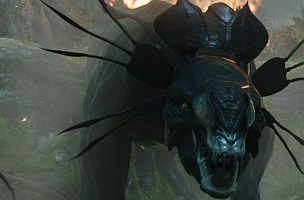
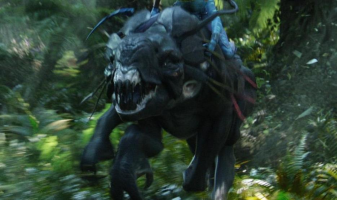
NA'VI NAME: Palatakan or "Dry Mouth Bringer of Fear"
HABITAT: Rainforest
DESCRIPTION: Most feared of all Pandorian land creatures. Massive distensible armored jaw. fangs are nine inches long. Upper lips fold back for maximum tooth extension. reaches over eighteen feet long, over eight feet in height.
FEEDING ECOLOGY: Omnivore with preference for nocturnal hunting
To read more about the biological aspects of the Avatar creatures, read AVATAR: THE FIELD GUIDE TO PANDORA
Thanator was designed by James Cameron himself.
James Cameron: "I visualized it in the writing as a six legged armored creature."
"The Thanator is like a great white shark is to a scuba diver. Its just death. When it comes after you it doesn’t not stop, it just digs everything out of the way."
"Its called Thanator, comes from archaic Greek, thanatos which is death. I was entertaining lots of ideas from a different designers and nobody would really ..nailing just that pure primal vicious alien quality that I wanted so I took that one and designed it myself."
"And then there’s the Thanator of course, which is my personal favorite. I think in the script I described it as a, it can it a T-Rex and have an alien for dessert."
"We were going back to nature the whole time and using resourcefulness and imagination to fuel what we were doin' which is why the creatures feel real"
Jon Landau: "When he does science fiction he has to do science fact for himself. I mean yes it’s a fantasy world but there has to be a foundation of reality. So we did a fair amount of research, we researched the plants, we worked with the botanists from UC Riverside, you know all the designers that we worked with, they didn’t come up with designs that did not make, you know, physical sense. They had a real foundation to why things work"
Sam Worthington: " Jim is an artist. (…) he drew then designed the Thanator, you know. It got tweaked by a couple of other guys you know when - cause he's busy, you know, making a movie, but the Thanator is the killing machine that Jim always told me it would be"
Yuri Bartoli, supervising conceptual artist creature design: "It all pretty much comes down to Jim and his sketches, I think he went through some detailing process but pretty much that’s his creature"
The most fearsome of all Pandorian land predators. Wide, armored tail can slam prey or defend against other thanatos. Cartilaginous plates around its neck that can flare, possibly as a threat display but more likely as an echolocation or other sensory pinpointing system. Given its anatomy, it is likely that Thanator is evolutionary relative to the viperwolf.
Although
many regions of the moon have yet to be explored, xenobiologists currently
believe that the Thanator may be the apex land predator on Pandora. Reminiscent
of a Terran panther, this enormous, powerful animal is unique in its ability to
lord over its territory and strike fear into the largest and fiercest of
Pandora's creatures. Even the Na'vi, who are renowned for their courage, are
shaken by the approach of the creature; it is not celebrated in dance or song.
Its musculature is pronounced and impressive, providing power for protracted
runs and leaps. The speed of its neck and jaw strike is as swift as a camera
shutter. In addition to conventional ripping and tearing, the Thanator can also
deliver a lethal blow from its armored tail. The Thanator's senses are so highly
developed that, depending on atmospheric conditions, it can detect prey up to
thirteen kilometers away.
The Thanator appears to hunt alone and normally does not stray outside of its
territory, which is believed to be roughly 300 square kilometers. It appears to
hunt mainly at night, although seems to make an exception if hungry enough.
Surprisingly, the Thanator has ten sensory quills, two each sprouting from armor
plating that encircles the rear of the skull. The function of the quills is
poorly understood, but it has been hypothesized that they may be tied to an
internal mechanism of prey location.
From Pandorapedia
9. WHAT IS THE MOST DANGEROUS SKY CREATURE ON PANDORA ?
The most dangerous sky creature on Pandora is the Leonopteryx.
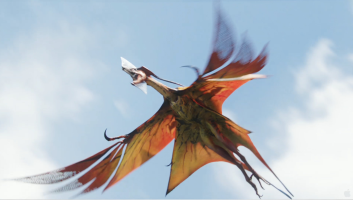
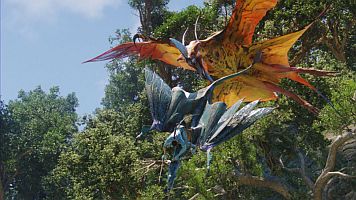
NA'VI NAME: Toruk or "Last Shadow"
HABITAT: Mountain series and skies
DESCRIPTION: A ferocious massive flying creature with a wingspan over eighty feet. Sharp fins on head can be used to injure prey. Powerful talons for grasping prey and perching.
FEEDING ECOLOGY: Apex aerial predator. Carnivore.
10. WHAT IS AN AMP SUIT ?
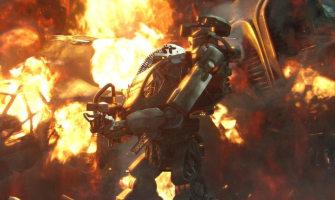
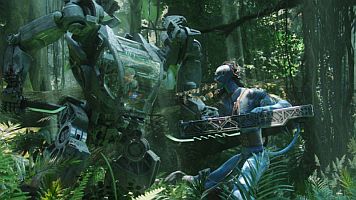
Ty Ruben Ellingson, vehicle designer: "In a nutshell its an amplifier (AMP) of a human operator which, you know, super hydraulics are all very strong so it can crush buildings and do all the things that like a tank would do. In this particular particular instance, the Amp Suit itself is more like a vehicle, the operator stays in his canapé and its inner interface that takes his movement and translates them to the outside limbs. So when the operator movies his hands lets say 10 inches, the machine might move it, you know, 10 to 20 feet."
OFFICIAL NAME: M6 Amplified Mobility Suit
FUNCTION: Ambulatory hydraulics armored weapons platform for military and civilian operations in hostile and toxic environments
FIELD NAMES: AMP Suit. Iron Lady
SIZE AND WEIGHT: Thirteen feet in height, six feet wide
FEATURES: GPS. Cockpit commands are verbally activated, coded to operator's voiceprint pattern. Thermal imaging display screens.
WEAPONRY: Hip mounted and detachable GAU-90 thirty millimeter cannon, optional flamethrower, slashing blade, knife.
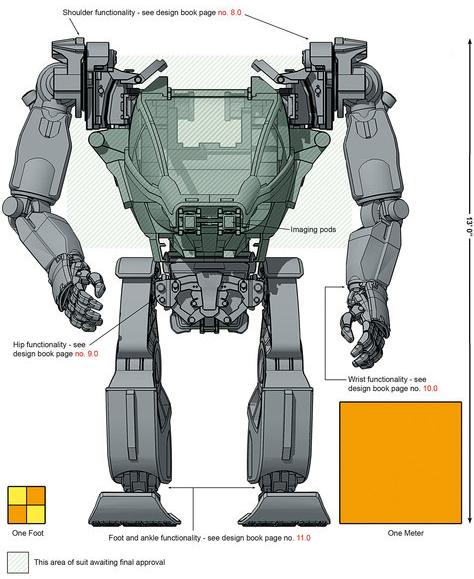 The AMP suit was also
personally designed by James Cameron
The AMP suit was also
personally designed by James Cameron
John Rosengrant, Legacy Effects, Stan Winston's Studio: "It was designed by Jim but when we got a hold of the amp suit it was pretty much designed in just a sketch up program which is designed for 3d work per say.
The whole thing is just covered in details and things that were thought out. You know and we studied very closely, you know, Apache helicopters, Abrams tanks, anything that we could kinda riff off of. It has a very typical Jim Cameron kinda look on the front of it "
"(...) Apache helicopters with legs. The soldiers on the planet use these things for both work purposes and going on patrol"
"Another fun thing is that if you look at the seat back, that's a, that there's the straps that go over it but the actual design of the back of the seat is the same one from the powerloader. (...) We molded and took that exact same pad that went behind Sigourney in Aliens, it's in there. So just a little fun nod"
The
Amplified Mobility Platform (or “AMP” Suit) is a distant descendant of the first
military exoskeletons used on Earth in the mid 21st century. It was improved
during military service in a myriad of combat theaters– from arctic to jungle to
desert– over the decades. Sealed and pressurized models for toxic environments
were developed as well. The suit is used extensively on the Moon and Mars
colonies (where they are powered by fuel cells and/or monopropellant ceramic
turbines). Its well-tested capabilities have proved invaluable in the deadly
environment of Pandora.
The human-operated walking machine magnifies the strength and mobility of a
soldier or civilian worker while providing protection from military and
environmental threats. Unlike fanciful designs in which weapons were integrated
into limbs, the AMP suit is a multi-purpose machine, able to duplicate all
functions of the infantry soldier. Since soldiers spend much of their time
loading and unloading, and performing other tasks besides operating weapons, it
was determined that the AMP suit needed the same functionality as a human: two
legs, two arms, and highly dexterous hands. This allows not only a wide range of
functions, but allows the suit to operate a variety of weapons systems.
The servo-actuated limbs instantly respond to the driver's hand and leg
movements inside the sealed cab, greatly magnifying the driver's strength.
The operator’s arms move servo armatures and the suit’s arms follow in perfect
synchronization. Because of limited space inside the cockpit, the servo
armatures move in a 1:2 ratio relative to the suit’s arms. It requires many
hours of training for an AMP suit driver to become agile and dexterous, with the
biggest difficulty being this scaled ratio of movement. The legs are actuated by
foot-pedals which amplify on an even larger ratio. In fact the leg sensors work
slightly differently than the arms. Due to the confining spatial envelope around
the feet and legs of the
operator, the pedals cannot move in long strides, even
on a scaled relationship. Instead, they sense the force and direction of the
input and the onboard computer triggers a corresponding programmed movement of
the legs. So the operator creates pressure and direction “cues” which trigger
leg movements. The suit executes the “intention” of the pilot, calculating
terrain factors and momentum to perform balanced movement. The
computerized maintenance
management systems installed in the suit
handles all the non-human controlled functioning of the AMP. While the
CMMS handles these functions, the pilot can
concentrate on the tasks assigned.
The arms on the other hand, operate in a directly scaled relationship to the
operator’s arms, which allows better spatial positioning of the hands. The
fingers and thumb are in direct 1:1 ratio. The servo armature has force
feedback, and resists the movement of the operator’s arms when the suit’s limbs
meet an obstacle. The operator can “feel” what the suit is doing. It is said
that the suit can be operated in full darkness, by a skilled driver, by “feel”
alone.
Using the suit, a driver is able to punch through a tree trunk, lift a half ton
cargo crate, or rapidly build prefab units without a construction crew. Its
cannon obliterates anything in its targeting sights with a rain of
armor-piercing rounds, at a 250 round per minute cyclic rate of fire.
Mission Profile and Specifications
\The AMP Suit is an agile, powerful all-terrain ground combat unit. With its
firepower, it can defeat most opponents and cut a swathe through difficult
landscape and strong enemy positions. The suit, which is made of composites and
ceramics, is lightweight for its size, and operates well in high EMF conditions.
The suit is effective against swarms of stinging, aggressive insects on Pandora.
Its enclosed cab and “Built-In Breathing System” (BIBS) also allows RDA
personnel to perform civilian and military duties in the toxic atmosphere of
Pandora and other off-Earth locations. The cockpit is run at a 0.3 psi
overpressure, to prevent leak-in of toxic gases. There is an emergency canopy
ejection system, in case a driver is trapped in a burning AMP suit.
Although a driver can learn to adequately manipulate the unit in combat
conditions with less than two months of training, it takes months longer to
master such actions as fall recovery from face-up supine position (the “turtle”
problem.)
However, with the solid state gyro sensors and the DBS (Dynamic Balance System)
very few AMP suits topple. Its dynamic balancing system automatically
compensates for shifts in the suit’s center of gravity whether standing,
walking, or lifting heavy loads. The suit instantly adjusts to radical shifts in
body movements on uneven terrain; it is very difficult to trip and it would take
a direct hit from a missile (or a thanator) to knock one over.
The force feedback in the arm and hand servo armatures is both powerful and
sensitive. It can create pressure against the operator which stops his hand in
mid air if the suit’s arm encounters an obstacle it cannot move. The pressure on
the fingertips is proportional to the pressure exerted by the suit’s fingers. An
experienced driver can pick up an egg without breaking it.
If the driver has been injured or killed, the AMP Suit has “walk-back”
capability of up to the range of its onboard fuel and reserve fuel-cells. This
feature was designed to protect the significant capital investment in each suit.
This function can be triggered by the driver, or from SecOps headquarters at
Hell’s Gate, if the driver’s biotelemetry indicate unconsciousness or death.
Only SecOps AMP suits are allowed beyond the perimeter at Hell’s Gate or at the
mine complex. Suits operated by non-SecOps base or mine personnel are not
equipped with a weapons system interface, nor do they have rack-space for ammo
canisters.
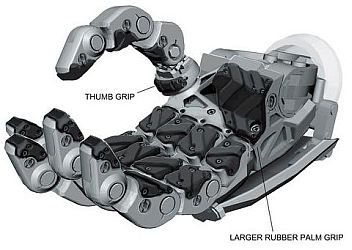 The unit's torso features an impact-resistant glass-polymer laminate canopy. The
lower legs and bottom of the feet are reinforced to protect against shrapnel and
mines.
The unit's torso features an impact-resistant glass-polymer laminate canopy. The
lower legs and bottom of the feet are reinforced to protect against shrapnel and
mines.
The power source is a 6849-RLF gas turbine engine. The ceramic miniturbine is a
standard power supply for all military systems and is highly robust in
environments of snow, sand, dust, and mud. The suit can operate at medium power
for up to eight hours on a full fuel load. A high energy-density fuel cell
provides a back-up energy source for up to two hours of use.
The controls for operating the system are inside the sealed cab. The turbine
runs a servo-motor system that moves the limbs by magnifying the driver's waist,
leg, feet, hand, arm, and finger movements through an electromechanical forced
feedback system. This increases the driver's physical strength by an average
factor of fifteen times. The hands can exert a grip of roughly 150 kilograms per
square centimeter– enough pressure to crush a metal pipe or smash through a
brick wall. Each suit must be custom calibrated to the driver for ease of use
and to avoid hyperextension injuries.
The suit's weapons are more lethal than its raw strength. The hip-fired GAU-90
thirty millimeter machine gun can fire 250 explosive rounds per minute. Ammo is
disintegrating-link belt fed from an ammo canister mounted on the unit's back
through a flex chute over the shoulder to the weapon. The gun can be slung using
an over-shoulder rifle-sling to free the hands for other tasks. The other
(non-standard) weapon is a combat knife of self-sharpening diamond-hard ceramic.
To match the scale of the suit, the blade is over one meter long and can cut
through many metals. (Although lethal, the blade is not as utilitarian as some
cutting devices and is considered to be something of an affectation, used mostly
by SecOps troopers with a “Special Forces” mentality.)
The utility version features the same technology and dimensions, but without the
weapons. Both models have proved extremely effective on Earth and Pandora.
Targeting Systems
The driver's HUD (head-up display) projects radar, active IR (infrared) and
passive thermal targeting data on an impact-resistant visor on top of the center
console. When the unit's blast shield is lowered over the cab canopy, the suit
can be operated using only visual instruments. In Pandora's EMF fields and high
humidity, these systems are notorious for failing. Because of their complex
Earth-manufactured electronics, they are difficult to repair.
When the driver’s hands are within the servo armatures, the driver uses voice
actuation to control suit systems. External sound can be monitored and
amplified, and is reproduced inside the cockpit with full directionality. The
driver can “hear” another AMP suit or ground trooper operating nearby, and know
their position by the direction of the sound. The driver’s voice can be
projected outside the suit via external speakers.
When the Master Servo Arm switch is activated by thumb control (on the left hand
armature) the suit’s servos move the limbs from rest position to the current
position of the driver’s arms and legs in one second. When the driver “switches
out,” hitting the MSA switch again (indicator goes from green to red) the suit
will relax from the current position of the operator to its standing rest
position in one second.
From Pandorapedia
11. HOW DO THE HALLELUJAH MOUNTAINS FLOAT ?
It all has to do with superconductors.
When superconductors are in the presence of a magnetic field, they can float.
"Avatar's" alien world of Pandora, it turns out, is simply a massive
superconductor. At the very beginning of the story, we are told that humans have
come to Pandora to mine unobtanium. Unobtanium is the ultimate superconductor.
(The very name, "unobtanium," is a nod to sci-fi afficionados, who coined the
word to describe a material with mythical properties.) In Cameron's world,
unobtanium can conduct electricity without resistance at room temperature; the
best current superconductors work only when the temperature is below minus 200
degrees F. The discovery of unobtanium, which exists only on Pandora,
revolutionized technology on Earth, the story goes, and the future human economy
is dependent upon it.
On Pandora, however, entire mountains loaded with unobtanium float in the
world's massive magnetic field. In a glimpse of how thoroughly Cameron has
thought through the science behind his creation, he and his team have written a
380 page "Pandorapedia" that explains (among other things) the tectonics behind
how such mountains could form. In effect, they crumble upward.
This happens because Pandora is not a planet but a moon of a gas giant the size
of Saturn -- the fictional planet Polyphemus. Moons of gas giants are constantly
tugged and deformed by the stresses of gravity. One of Jupiter's moons, Io, is
pulled so violently by the gravitational forces of both Jupiter and Jupiter's
other large moons, that it has ground tides -- the ground literally rises and
falls like a sea tide on Earth. On a second moon of Jupiter, Europa, these tidal
forces have heated the interior of the moon to the point that part of its crust
has melted, creating a sea of liquid water beneath a surface of ice, scientists
say.
On Cameron's Pandora, those tidal stresses have fractured the landscape, and, in
the case of the Hallelujah Mountains, sent it up into the sky. A companion book
to the movie explains the larger process: "This … energy drives continental
drift at a much faster rate than on Earth, causing tectonic plates to fracture
more extensively because of the increased stress." The original script
explained this calling them "Big rock candy Mountains" because they were full of
Unobtainium. The reason why RDA isn't mining them is explained in the companion
book "Avatar: an Activist Survival Guide". The RDA originally was mining the
mountains, but after one mountain was mined from the bottom too much, it became
top heavy and flipped over, killing a huge number of workers and ruining much
equipment. After this incident the RDA stuck to mining more safe locations of
the substance. The
water comes from the same source that
normal mountains with
waterfalls have: rain and snow.
12. WHY HUMANS DON'T WEAR PROTECTIVE SUITS ?
Pandora's air contains some amount of gasses that are poisonous to humans but it also contains oxygen. Clearly James Cameron, a diving and deep sea enthusiast, thought of this, because the people only need simple gas masks to breathe and not huge oxygen tanks.
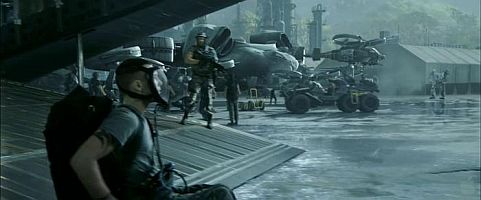
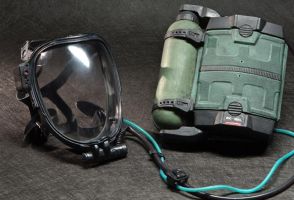
13. HOW CAN THE PLANTS GLOW?
![]()
The
oceans' depths have a curious answer to sunlight, which has never been seen
there. It's called bioluminescence -- organisms' ability to create their own
light.
Fireflies are perhaps the most obvious example, but the bioluminescent fish of
the deep sea tell a different story -- that nature, when deprived of light,
sometimes creates its own.
On Pandora, where the nights can be many Earth days long, Cameron has suggested
that an entire bioluminescent ecosystem could emerge.
This is where Cameron's decision to make Pandora a moon -- and not a planet --
comes in. Moons, including Earth's, are typically "locked" to their planets,
with one side eternally facing the planet and one side eternally facing out into
space. What this means is that one day on a moon equals the time it takes to
orbit its parent planet -- a long time.
To watch the phases of our Moon is actually to watch the lunar day in real time.
A full moon is midday for the side of the Moon facing the Earth. A new moon is
midnight for the side of the Moon facing the Earth. In other words, a lunar day
takes more than 27 Earth days. And that means a very long night.
14. CAN A MOON HOLD LIFE?
15. WHY DO THE NA'VI HAVE FOUR LIGAMENTS WHEN THE REST OF THE PANDOREAN ANIMALS HAVE SIX ?
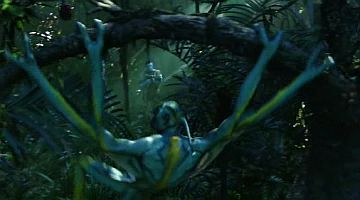
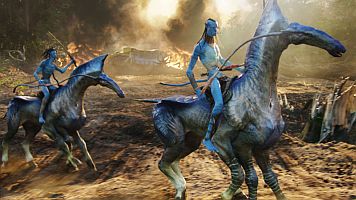
James
Cameron: "I even debated giving them extra arms. [....] It was a serious
consideration for a while, but the decision was made that the actors wouldn't be
able to physically perform their characters effectively if they had extra arms,
that the animators would have to step in and change the performance too much.
'Cause every other critter on the planet has got six limbs, but the Na'vi don't,
they have four. So what we did was show an intermediate stage with the
prolemuris [....] it actually has a split four-limb. It has two hands on each
limb. So it looks like it's a transitional state between six and four."
Cameron explained that part of the reason that they seriously considered giving
the Na'vi six arms was in keeping with the "Hindu pantheon", from which the word
"avatar" originates, where Vishnu is a blue deity with four arms.
16. WHAT ARE SOME OF THE WEAPONS USED IN THE MOVIE?
![]()
![]()
![]()
![]()
![]()
![]()
![]()
![]()
![]()
![]()
ADDITIONAL INFORMATION
Avatar is the story of an ex-Marine who finds himself thrust into hostilities on an alien planet filled with exotic life forms. As an Avatar, a human mind in an alien body, he finds himself torn between two worlds, in a desperate fight for his own survival and that of the indigenous people. The story follows the adventures of the Avatar through the planet of Pandora while the industrial complex of the mining and moving companies pushes forward with only profit and financial gain in mind. Humans have been sent as long distance moving companies to mine precious mineral from the Planet Pandora. The mining and moving companies are protected by marines during the expedition. To better interact with the natives of the planet, Avatars are used. More than ten years in the making, Avatar marks Cameron's return to feature directing since helming 1997's Titanic, the highest grossing film of all time and winner of eleven Oscars® including Best Picture. WETA Digital, renowned for its work in The Lord of the Rings Trilogy and King Kong, incorporates new intuitive CGI technologies to transform the environments and characters into photorealistic 3D imagery that will transport the audience into the alien world rich with imaginative vistas, creatures and characters. AVATAR takes us to a spectacular world beyond imagination, where a reluctant hero embarks on an epic adventure, ultimately fighting to save the alien world he has learned to call home.
James Cameron first conceived the film in 1995, when the means to realize his vision did not yet exist. Now, after four years of production, AVATAR, a live action film with a new generation of special effects, delivers a fully immersive cinematic experience of a new kind, where the revolutionary technology invented to make the film, disappears into the emotion of the characters and the sweep of the story.
AVATAR
2009 20th Century Fox, Lightstorm Entertainment, Dune Entertainment, Ingenious Film Partners
Director: James Cameron
Writer: James Cameron
Producers: James Cameron and Jon Landau
Actors: Sam Worthington, Zoe Saldana, Sigourney Weaver, Stephen Lang
Composer: James Horner
Release Date: December 18, 2009
Running Time: 2 hrs. 40 min.
MPAA Rating: PG-13 Production Budget: $237,000,000
Academy Award

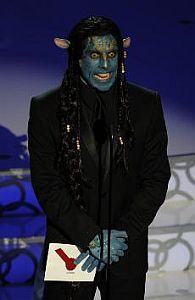
Won:
Best Achievement in Art Direction
Best Achievement in Cinematography
Best Achievement in Visual Effects
Nominated:

Best Motion Picture of the Year
Best Achievement in Directing
Best Achievement in Editing
Best Achievement in Music Written for Motion Pictures, Original Score
Best Achievement in Sound
Best Achievement in Sound Editing
Golden Globes:

Won:
Best Director - Motion
Picture
Best Motion Picture - Drama
Nominated:
Best Original Score - Motion Picture
Best Original Song - Motion Picture
Broadcast Film Critics Association Awards
Won:
Best Action Movie
Best Art Direction
Best Cinematography
Best Editing
Best Sound
Best Visual Effects
Nominated:
Best Director
Best Makeup
Best Picture
Black Reel Awards
Nominated:
Best Supporting Actress
Zoe Saldana
Chicago Film Critics Association Awards
Nominated:
Best Cinematography
Best Original Score
Directors Guild of America, USA
Nominated:
Outstanding Directorial
Achievement in Motion Pictures
James Cameron
BAFTA Awards
Won:
Best Production Design
Best Special Visual Effects
Nominated:
Best Cinematography
Best Director
Best Editing
Best Film
Best Music
Best Sound
Florida Film Critics Circle Awards
Won:
Best Cinematography
Las Vegas Film Critics Society Awards
Won:
Best Art Direction
London Critics Circle Film Awards
Nominated:
Director of the Year
James Cameron
Film of the Year
Online Film Critics Society Awards
Nominated:
Best Cinematography
Best Director
Best Editing
PGA Awards
Nominated:
Motion Picture Producer
of the Year Award
James Cameron
Jon Landau
Phoenix Film Critics Society Awards
Won:
Best Cinematography
Best Film Editing
Best Production Design
Best Visual Effects
Writers Guild of America, USA
Nominated:
Best Original Screenplay
James Cameron
Empire Awards
Won:
Best Director
Best Film
Best Actress
Zoe Saldana
Nominated:
Best Actor
Sam Worthington
Best Sci-Fi/Fantasy
Academy of Science Fiction, Fantasy & Horror Films
Nominated:
Best Actor
Sam Worthington
Best Actress
Zoe Saldana
Best Director
Best Fantasy Film
Best Music
Best Production Design
Best Special Effects
Best Supporting Actor
Stephen Lang
Best Supporting Actress
Sigourney Weaver
Best Writing
American Cinema Editors
Nominated:
Best Edited Feature Film (Dramatic)
American Society of Cinematographers
Nominated:
Outstanding Achievement in Cinematography in Theatrical Releases
Art Directors Guild
Won:
Excellence in Production Design Award
Cinema Audio Society
Nominated:
Outstanding Achievement in Sound Mixing for Motion Pictures
Costume Designers Guild Awards
Nominated:
Excellence in Costume Design for Film - Fantasy
César Awards
Nominated:
Best Foreign Film
Image Awards
Nominated:
Outstanding Supporting
Actress in a Motion Picture
Zoe Saldana
Irish Film and Television Awards
Nominated:
Best International Film
Motion Picture Sound Editors
Won:
Best Sound Editing -
Music in a Feature Film
Best Sound Editing - Sound Effects and Foley in a Feature Film
Nominated:
Best Sound Editing - Dialogue and ADR in a Feature Film
Visual Effects Society Awards
Won:
Best Single Visual
Effect of the Year
For Quarich's escape.
Outstanding Animated
Character in a Live Action Feature Motion Picture
For Neytiri.
Outstanding Created
Environment in a Feature Motion Picture
For the jungle/biolume.
Outstanding Matte
Paintings in a Feature Motion Picture
For Pandora.
Outstanding Models and
Miniatures in a Feature Motion Picture
For Samson/home tree/floating mountains/ampsuit.
Outstanding Visual Effects in a Visual Effects Driven Feature Motion Picture
Nominated:
Best Single Visual
Effect of the Year
For Neytiri drinking.
Outstanding Compositing
in a Feature Motion Picture
For the end battle.
Outstanding Compositing
in a Feature Motion Picture
Outstanding Created Environment in a Feature Motion Picture
For the Willow Glade.
Outstanding Created
Environment in a Feature Motion Picture
For the floating mountains.